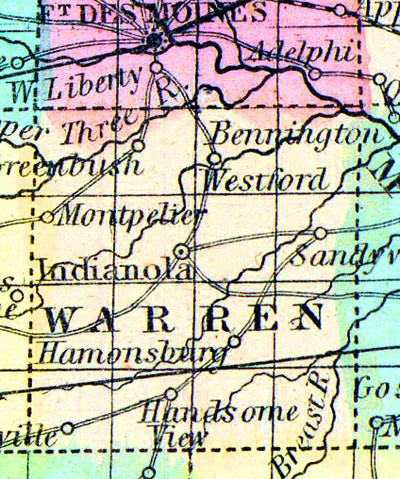WARREN, a new county in the S. central part of Iowa, has an area of 432 square miles. It is traversed by South river, an affluent of the Des Moines, and by the Prairie branch of Middle river, and also drained by Squaw, Otter, and other creeks. The surface is divided between prairies and woodlands: the soil is productive. Indian corn, butter, and wool are the staples. In 1850, Warren county produced 23,920 bushels of corn; 633 of wheat, 1242 pounds of wool, and 5530 of butter. There were 115 pupils attending public schools. Stonecoal is said to be abundant. Capital, Indianola. Population, 961. (Baldwin's New and Complete Gazetteer of the United States..., 1854)
WARREN COUNTY Is situated in the southern central part of the State, and is bounded on the north by Polk County, on the east by Marion, on the south by Lucas and Clark, and on the west by Madison.
The general surface is gently rolling, about one-fourth being timber, which is well divided through all portions of the county, no prairie being wider than six miles. The soil is a sandy loam, with a general depth of three feet, and well adapted to the different cereals, grasses, fruits, root crops, etc. Apples, pears, grapes, plums and cherries of fine quality are grown in abundance.
The principal varieties of timber are sugar maple, black walnut and white oak. Building stone is plenty, but generally difficult of access, although it crops out on some of the streams. There are large beds of excellent stone coal in different parts of the county, and a vein of cannel coal has recently been discovered. The county is well adapted to stock raising, as the timber being well divided, gives an abundant shelter. Sheep growing is attracting the attention of the farmers. During the fall of 1864, twenty thousand head of sheep were brought here. A woolen factory is much needed, and there are good facilities for putting one in operation.
The DesMoines River bounds the county on the northeast, and flowing into it are the North, Middle and South Rivers. White Breast River runs through the southeast corner, and Squaw River through the southern portion into South River. All the above mentioned are large enough for mill seats, and have a fair fall of water. Beside these, there are innumerable smaller streams, which drain the prairies and furnish good stock water at various intervals.
The county is divided into sixteen civil townships, as follows: Allen, Belmont, Greenfield, Jackson, Jefferson, Liberty, Linn, Otter, Palmyra, Richland. Squaw, Union, Virginia, Washington, White Breast and White Oak. As yet there is no railroad passing through the county, the nearest being the DesMoines Valley Railroad, which passes the northern portion of the county on the opposite side of the DesMoines River. This railroad will soon be finished to DesMoines, which will be the principal shipping point for Indianola, seventeen miles distant.
The county was first settled by Alexander Gindler, Samuel Hayworth, Joseph Scott and David Booker, in 1848-49. It was organized January 1st, 1849. Samuel Hayworth, Daniel Booker and Alexander Gindler were the organizing commissioners. (Hair's Iowa State Gazetteer..., 1865)

